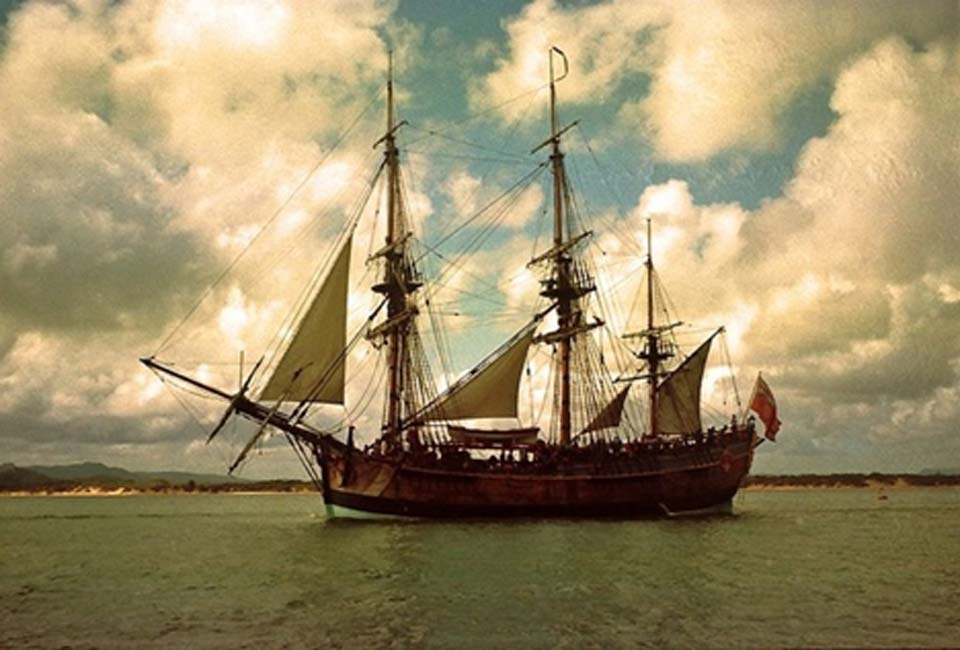Would the REAL Endeavour Shipwreck Please Stand Up?
Has Captain Cook’s shipwrecked 'Endeavour', one of the most famous research ships in history, finally been identified off Rhode Island?
The HMS Endeavour was built originally for the transportation of coal. It was bought and transformed by the Royal Navy and on August 26, 1768, Royal Navy Lieutenant, (later Captain) James Cook departed from Plymouth carrying 94 people onboard ‘ Endeavour’, including scientists of the Royal Society like Joseph Banks, the botanist and astronomer Charles Green. In 1769 the scientists observed the planet Venus transiting the Sun in Tahiti. Cook then mapped the coast of New Zealand in the South Pacific before making the first European landing in Botany Bay, Australia, in 1770.
Now Cook’s ship, the Endeavour, might have been discovered resting at the bottom of Newport Harbor in Rhode Island, USA, and the new research results say the ship was wrecked in 1778 during the American War of Independence, at which time it had been renamed the ‘ Lord Sandwich.’

Scale model believed to be of the Endeavour (© Historic Marine, Mauritius)
No ‘Captain Cook Slept Here’ Sign
Marine investigators first detected the wreck in 1993 and a report published by Kathy Abbass, Principal investigator of the Rhode Island Marine Archaeology Project (RIMAP) disclosed the recent findings of divers from RIMAP. Among the “hundreds of artifacts” were wooden fragments, leather, textiles, glass, ceramics, gun flints and ballast stones.
Abbass told Live Science that the divers wouldn’t find something as telling as “Captain Cook slept here”, but knowing that it was utilized as a British prison ship in Newport Harbor, evidence relating to this application will maybe confirm that scientists “have got her,” she said. As historians believe the Endeavour’s keel was crafted from elm, the researchers are hopeful that samples of wood from the keel of the mystery ship shipwreck will also prove to be elm wood.
- Two Roman Ships that Were Lost in WWII: What Destroyed the Floating Palaces of Emperor Caligula?
- Forgotten, Lost, or Destroyed? Exploring the Final Fate of the Famous Three Ships Led by Columbus
- Byzantine shipwrecks reveal advanced shipbuilding techniques

Resolution and Adventure with fishing craft in Matavai Bay, painted by William Hodges in 1776, shows the two ships of Commander James Cook's second voyage of exploration in the Pacific at anchor in Tahiti. (Public Domain)
Endeavour’s Imposter
One might query what on earth was such an important scientific ship doing fighting in the American War of Independence? After returning to England from its circumnavigational adventure, the Royal Navy sold the Endeavour and she was renamed the ‘ Lord Sandwich’, becoming a troop transporter for British soldiers heading to fight in the escalating war in the New World.
In 1778 France was an ally of the Americans and when they scuttled the British fleet in Newport Harbor, the Lord Sandwich was one of about 13 shipwrecked.

Cook's landing at Botany Bay in 1770. Lithograph by unknown artist, first published in the Town and Country Journal New South Wales, 21 December 1872 (Public Domain)
A wreckage was discovered in 2016 in the Bay of Newport, believed to be the Endeavour. Since 1994, a replica of the ship is maintained in Sydney Harbor (Australia), at the National Maritime Museum dock. In Sea World, also in Australia, another replica has been presented since 1972. Now it is believed archaeologists had an ‘incorrect' Lord Sandwich in Newport and that it was actually a ship named La Liberté; pieces of which went on a world tour and according to space.com a tiny piece was sent into space on the Apollo 15 moon mission.

Painting of the Earl of Pembroke, later HMS Endeavour, leaving Whitby Harbour in 1768 by Thomas Luny (Public Domain)
While this level of mistake would cause many to stay at home for weeks, avoiding some pretty awkward office meetings, Abbass said historians now think La Liberté was formerly HMS Resolution; Cook’s flagship on his 1772 to 1775 AD, second, round-the-world voyage. The scientists are excited to think that two of Cook's four round-the-world ships have ended up at the bottom of Newport, within a few miles of each other, both renamed, and their former glory hidden by the Rhode Island silts.
Dirty Diving
It is these same silts that caused the poor visibility which forced the RIMAP divers to halt their investigation until winter when Newport Harbor will have better visibility. Let’s talk about these divers for a moment, because it would not be balanced or fair to assign too much of this discovery to the land-based scientists.
Only last year Cape Cod archaeological divers won my uttermost respect when I read an article about divers at Nauset Inlet, Catalano, searching the wreck of the Whydah Galley, a pirate ship and former slaver that sank off Wellfleet in 1717. Aside from the wide range of variables which make diving inherently dangerous, east coast North American divers fight two main adversaries.

Model of the Whydah Galley (CC BY-SA 2.0)
The first life threatening natural occurrence is a summer-blooming brown algae known as mung, which commercial Diver Jeff Denholm, of Santa Cruz, California told NewportRI, can reduce visibility to only a few feet.
Searching for pirate artifacts at 164 feet (50 meters) deep and being wrapped in a blanket of mung sounds like a nightmare, right? But relative to the second threat it’s a walk in the park; they have to launch drones 1,500 feet (457 meters) high above their dive sites on the look-out for great white sharks. Pirate artifact hunters get preyed on by great white sharks – sounds like the blurb for a movie.
Top Image: HM Bark Endeavour replica in Cooktown (John Hill/ CC BY-SA 3.0)
By Ashley Cowie




















Comments
My sisters husband is a descendant of Captain Cook
Mary Madeline